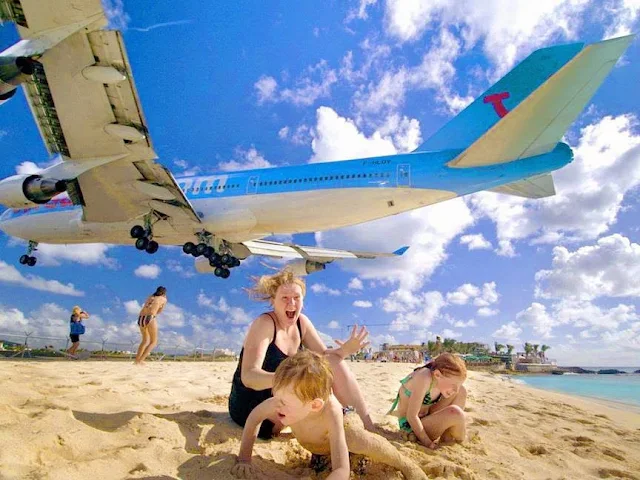Princess Juliana International Airport (also known as Saint Maarten International Airport) is the main airport on the Caribbean island of Saint Martin, located on the Dutch side of the island in the country of Sint Maarten. In 2010, the airport handled 1,645,105 passengers and 60,870 aircraft movements. The airport serves as a hub for Windward Islands Airways and is the major gateway for the smaller Leeward Islands, including Anguilla, Saba, St. Barthélemy and St. Eustatius. It is named after Juliana of the Netherlands, who as crown princess landed here in 1944, the year after the airport opened. There is also an airport on the French side of the island, called Aéroport de Grand Case or L'Espérance Airport.
The airport is perhaps best known for very low-altitude flyover landing approaches due to one end of its runway being extremely close to the shore and Maho Beach.
The airport was started as a military airstrip in 1942. It was converted to a civilian airport in 1943. In 1964 the airport was remodeled and relocated, with a new terminal building and control tower. The facilities were upgraded in 1985 and 2001. Because of increased passenger traffic and the expected growth of passenger traffic in the near future, Princess Juliana International Airport is being heavily modernized following a three-phased masterplan, commissioned in 1997.
Phase I was a short-term program in order to upgrade existing facilities and improve the level of service at various points. This included widening, strengthening and renovating the runway, increasing the bearing capacity of the taxiways, construction of a new apron and an upgrade of the (old) terminal. Phase I was completed in 2001.
Phase II included the construction of a radar facility and a new air traffic control tower, the construction of a new and more modern, 27,000 square metres (290,000 sq ft), terminal, capable of handling 2.5 million passengers per year, and the construction of a Runway End Safety Area (RESA) of 150 metres (490 ft), including a 60 metres (200 ft) overrun, on both ends of its runway, to comply with ICAO rules. The new air traffic control tower and the radar station commenced operations on 29 March 2004, while the new terminal opened in late October 2006. The terminal has 4 jetways for large aircraft like 747s.
If traffic develops as forecast, Phase III of the masterplan will be executed, consisting of an extension of the new terminal building and the construction of a full parallel taxiway system. The new terminal building will also have more jetways and services etc.
However, the oil price increases since 2003 began impacting discretionary air travel worldwide by early 2008, and the prospect of further price increases threatens to reverse the recent expansion of tourist travel by jet which began with the 1980s oil glut.
In 1994, the Kingdom of the Netherlands and France signed the Franco-Dutch treaty on Saint Martin border controls, which allows for joint Franco-Dutch border controls on so-called "risk flights". After some delay, the treaty was ratified in November 2006 in the Netherlands, and subsequently entered into force on 1 August 2007.
In July 2016, KLM announced to serve the airport with direct flights from Amsterdam instead by a triangle route via Curaçao from October 2016. Due to this change, the airport lost its last regular Boeing 747 service - which was a famous photo opportunity on the nearby beach - as KLM uses Airbus A330s for the changed schedule.
Because the approach to Runway 10 is over water, pilots can become disoriented regarding their perceived altitude when operating under visual flight rules. Normal instrument checks, coupled with experience and situational awareness, mitigate potential problems. The departure from Runway 10 presents more "difficulties" than the approach, with a turn required to avoid mountains in the departure path.
Arriving aircraft approach the island on the last section of the final approach for Runway 10, following a 3° glide slope flying low over the famous Maho Beach. Pictures of low flying aircraft were published in several news magazines worldwide in early 2000. The thrilling approaches and ease of access for shooting spectacular images, made the airport one of the world's favorite places among planespotters. To meet changing international and local regulations a 150-metre (490 ft) safety extension was required.
Despite the reputed difficulties in approach, there have been no records of major incidents at the airport, although ALM Flight 980 crashed 30 miles (48 km) from St. Croix on 2 May 1970, after several unsuccessful landing attempts at TNCM in bad weather. Runway 10/28 was renumbered from 09/27 in late 2008. The runway is 45m wide.
Arriving aircraft approach the island on the last section of the final approach for Runway 10, following a 3° glide slope flying low over the famous Maho Beach. Pictures of low flying aircraft were published in several news magazines worldwide in early 2000. The thrilling approaches and ease of access for shooting spectacular images, made the airport one of the world's favorite places among planespotters. To meet changing international and local regulations a 150-metre (490 ft) safety extension was required.
Despite the reputed difficulties in approach, there have been no records of major incidents at the airport, although ALM Flight 980 crashed 30 miles (48 km) from St. Croix on 2 May 1970, after several unsuccessful landing attempts at TNCM in bad weather. Runway 10/28 was renumbered from 09/27 in late 2008. The runway is 45m wide.
for more details = Princess Juliana International Airport












No comments:
Post a Comment
Stay updated with our blog for more quality content! Your feedback is appreciated. Contact us at harshrex@outlook.com with any suggestions.